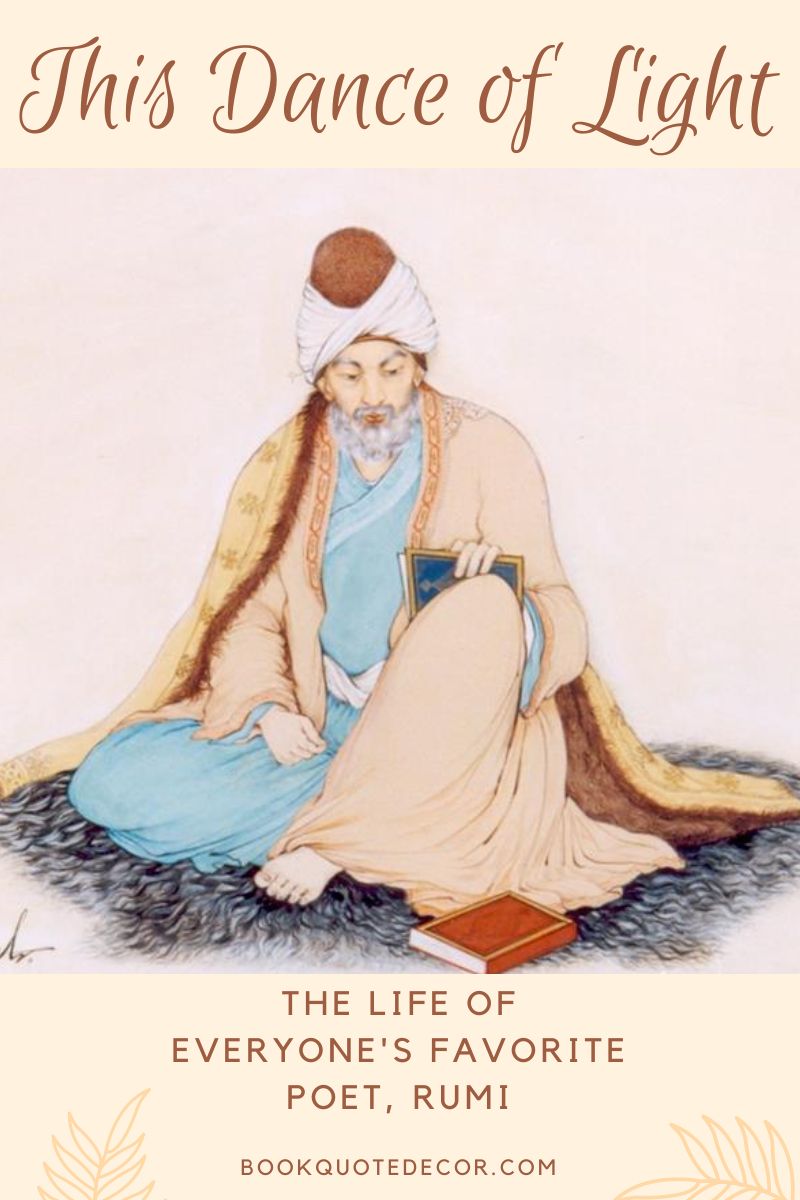- Home
-
Shop All
- Bible Verse & Christian
- Black & White Art Prints
- Book Lover Quotes
- Feminist Quotes
- Book Quote Mugs
- Fine Art Quote Prints
- Inspirational Wall Art
- Jane Austen Quotes Prints
- Jane Eyre & Bronte Art
- Love Poems & Quotes
- Minimalist Art Prints
- Nursery Decor Prints
- Other Options & Custom
- Poetry Quote Art
- Shakespeare Quotes Prints
- Travel Quote Art
- About
- Blog
- Track Order
- Contact Us

This Dance of Light: The Life of Everybody's Favorite Poet, Rumi
If you asked most people who the best-selling poet in the United States is, not many would think it was a Muslim scholar born over 800 years ago. And yet, Rumi's timeless poetry is beloved by so many the world over. But who is this mysterious poet, who writes such moving and lyrical words that speak directly to the reader. Read on for my short bio of the most romantic poet who has ever lived...

A portrait of Rumi - poet, mystic, teacher, scholar
Rumi had an itinerant childhood. His father was a prominent preacher and jurist. Rumi was born in Wakhsh, now modern-day Tajikistan. The family moved from Rumi's birthplace at the arrival of the invading Mongols somewhere between 1215 and 1220. They passed through Baghdad, Damascus and many other places before settling in Karaman, South-Eastern Turkey, for several years. Here Rumi married and had three children with his wife, Gowhar Katun. After seven years, they moved to Konya, where Rumi would spend the rest of his life.
"The Privileged Lovers" Poem Print

A portrait of Jalāl al-Dīn Muḥammad Rūmī
When Rumi was 37 years old, he met the person who would have the greatest influence on his life. This person was known as Shams of Tabriz, a wandering mystic. While their friendship would only last three until his friend's untimely death, it would completely change the trajectory of the next thirty years of his life and influence an enormous body of work - including a six-volume, 27,000 line epic, The Masnavi.
"A Moment of Happiness" Poem Print

A page of a copy c. 1503 of the Diwan-e Shams-e Tabriz-i
So why is his work so enduring? While his works assert authority to Islam, much of his work touches on eternal themes: love, joy, mystery and a devotion for these themes. Much of his work also addresses the reader in the second person, an unusual device that makes it feel like he is directly addressing the reader. In some ways, the interest in these universal themes has erased away Rumi's Muslim roots. But it is no surprise that readers of all faith and nations would enjoy reading a poet whose work embraces universality of all things.

Rumi's burial place
Rumi's death was met with an outpouring of grief, and his funeral was attended by a diverse crowd of Jews and Muslims. Rumi is buried in Konya, Turkey. His grave is called Qubba-t-al-Hadra, or "The Green Place", built by one of his close friends, the Georgian queen Gurju Khatun. It is a popular pilgrimage site, attracting thousands of visitors every year.

Whirling dervishes
In 1273, his followers founded the Mewlewī Sufi order. Since 1284 to this day, the leadership of this order has come from Rumi's direct descendants. His followers gather each year for a whirling dervish ceremony on 17 December, the anniversary of his death. This is where his followers gather for a musical, "turning" practice that Rumi himself engaged in during his meditations, whereby he would turn and recite poetry.
Read: Soul of Rumi: a Collection of Ecstastic by Coleman Barks
Rumi's Secret: The Life of the Sufi Poet of Love
The Erasure of Islam in the Poetry of Rumi by Rozina Ali (New Yorker, 2017)
Look : A manuscript at the Met of Masnavi of Jalal al-Din Rumi
Other articles:
Quick links
Search
FAQ
Privacy policy
Shipping Policies
Terms of service
OUR MISSION
At BookQuoteDecor.com, we’re passionate about transforming spaces with the magic of words. We create premium, literature-inspired decorations that not only beautify your home but also celebrate the timeless elegance of written language. Our mission is to bring the wonder of books into your daily life with every carefully selected quote.




Leave a comment: